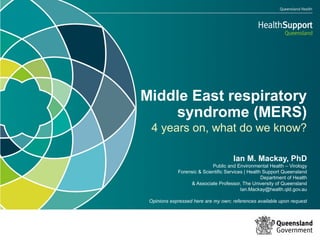
PEH FORUM_29SEPT2016
- 1. 4 years on, what do we know? Ian M. Mackay, PhD Public and Environmental Health – Virology Forensic & Scientific Services | Health Support Queensland Department of Health & Associate Professor, The University of Queensland Ian.Mackay@health.qld.gov.au Opinions expressed here are my own; references available upon request Middle East respiratory syndrome (MERS)
- 2. 2PEH FORUM 29SEPT2016 Middle East respiratory syndrome coronavirus (MERS-CoV)
- 3. 3 Kingdom of Saudi Arabia (KSA) is the hot zone •1st report of novel CoV– 20th Sept 2012 •Most cases are from human-to-human transmission • respiratory disease caused by a respiratory virus • weak & sporadic transmission between humans • acquired mostly from humans in healthcare settings •Seroprevalence: 0.15% • 2013, 15 of 10,009 adults, KSA • highest seroprevalence among shepherds and slaughterhouse workers PEH FORUM 29SEPT2016
- 4. The hot zone is hot & subtropical 4PEH FORUM 29SEPT2016
- 5. Hajj: “The massest of Mass gatherings” -Helen Branswell 5PEH FORUM 29SEPT2016
- 6. The MERS coronavirus (MERS-CoV) •Enveloped, 30,000nt (+) RNA virus •4 structural ( ), 16 NS proteins; recombination •Little sign of adapting to humans so far •Single serotype •Uses dipeptidyl peptidase 4 (DPP4; LRT>URT) for entry 6PEH FORUM 29SEPT2016
- 7. Hu et al. Virol J .2015 12:221 Ancestors of MERS-CoV •Bats • focus of first papers • many recent CoVs discovered • likely ancestor found •Conspecific virus • Neoromicia (Pipistrellus) capensis • South Africa • “NeoCoV” 7PEH FORUM 29SEPT2016
- 8. 8PEH FORUM 29SEPT2016 MERS-CoV in bats •1 rtPCR amplicon • 1 sample • 1 bat • 1 species (Taphozous perforatus) • 1,003 samples Oct 2012 / April 2013 • not convincing
- 10. 10 Why camels? •Important animals – much contact • Arabian peninsula •Mild camel disease – common cold • 1st MERS case did own camels • juvenile camels more often virus positive • high level of virus in camel secretions • Camel herds can be 100% seropositive • Camel-to-human infection reported •No other animal found to host virus • alpaca with antibody PEH FORUM 29SEPT2016
- 11. 11PEH FORUM 29SEPT2016 Camel virus > human spillover •Same virus in camels & humans •225 genomes • 3 genetic groupings •Camel & human variants • interspersed • 96.5-100% nt identity
- 12. 12PEH FORUM 29SEPT2016 MERS-CoV: A distinct virus
- 14. Example of rare contact 14PEH FORUM 29SEPT2016
- 15. More likely forms of contact 15PEH FORUM 29SEPT2016
- 16. Persistence •MERS-CoV is stable on surfaces • more stable than influenza A(H1N1) virus in aerosol (10min) & on hard surfaces •MERS-CoV RNA can shed for >1 month • detected from a HCW for 42 days 16PEH FORUM 29SEPT2016
- 17. The disease, MERS •Incubation period 2-16 days (median 4/5 days) •Comorbidity (e.g. 87%) & cough (e.g. 100%) common • asymptomatic • acute URT illness incl. fever, headache, myalgia • progressive pneumonitis, respiratory failure, septic shock, multi-organ failure •20% -74% (ICU) mortality (median: 12 days onset>death) • SARS-10% 17PEH FORUM 29SEPT2016
- 18. Treatment •No antivirals available •Passive immunotherapy (antibody) - clinical effect? • infrequent donors (2%) • antibody titres low/short-lived in convalescent human sera •Vaccines • a range in the pipeline for humans and animals •Supportive care 18PEH FORUM 29SEPT2016
- 19. 19PEH FORUM 29SEPT2016 MERS in humans is about humans with MERS ?
- 20. 20 MERS: cases driven by habits and errors? PEH FORUM 29SEPT2016
- 21. South Korea outbreak, May-Dec 2015 •186 cases, 38 fatalities (20%), 4 waves of infection •Biggest outbreak outside KSA • >16,000 people quarantined •No sustained h2h transmission • no community outbreaks •1/186 case travelled to China •7.4 day incubation period (6.2 > 7.7 > 7.9 by generation) 21PEH FORUM 29SEPT2016
- 22. South Korea outbreak, May-Dec 2015 •1 patient responsible for 81 cases • visited 4 hospitals • coughed in the open • walked through ER to public toilet •Receptor binding domain mutant in 13/14 variants • reduced receptor affinity • not every virus mutates according to a Hollywood script 22PEH FORUM 29SEPT2016
- 23. South Korea outbreak, May-Dec 2015 •Lower proportion fatal •20% compared to 41% in KSA • due to the mutation? • lower % underlying comorbidities in general community 23PEH FORUM 29SEPT2016
- 24. South Korea outbreak washup •Quarantine was initially limited • casual contacts needed to be included as well as close contacts •4 beds/room – cases initially not isolated • overcrowding •Family members were responsible for some hospital care • prolonged, close contact •Patients easily moved between hospitals • hospitals didn’t share past disease history on patients 24PEH FORUM 29SEPT2016
- 25. South Korea outbreak, May-Dec 2015 25PEH FORUM 29SEPT2016 1-Choi. Yonsei Med J. 2015 56(5):1174-76
- 27. Issues to address large healthcare outbreaks of MERS •Identify symptomatic patients early; test & re-test •Strong contact tracing, monitoring and quarantine •Strong infection, prevention and control measures • PPE – selection, use, donning/doffing, disposal • distance between beds • be aware of aerosol generating procedures • cleaning & disinfection • treat / manage patients in isolation •Communicate with public to build/maintain trust 27PEH FORUM 29SEPT2016
- 28. 28 Cases are rare but travel is not •Control MERS in the hotzone, avoid global spread PEH FORUM 29SEPT2016
- 29. Stop hospital outbreaks, reduce MERS cases •Humans create circumstances for super-spreading events 29PEH FORUM 29SEPT2016